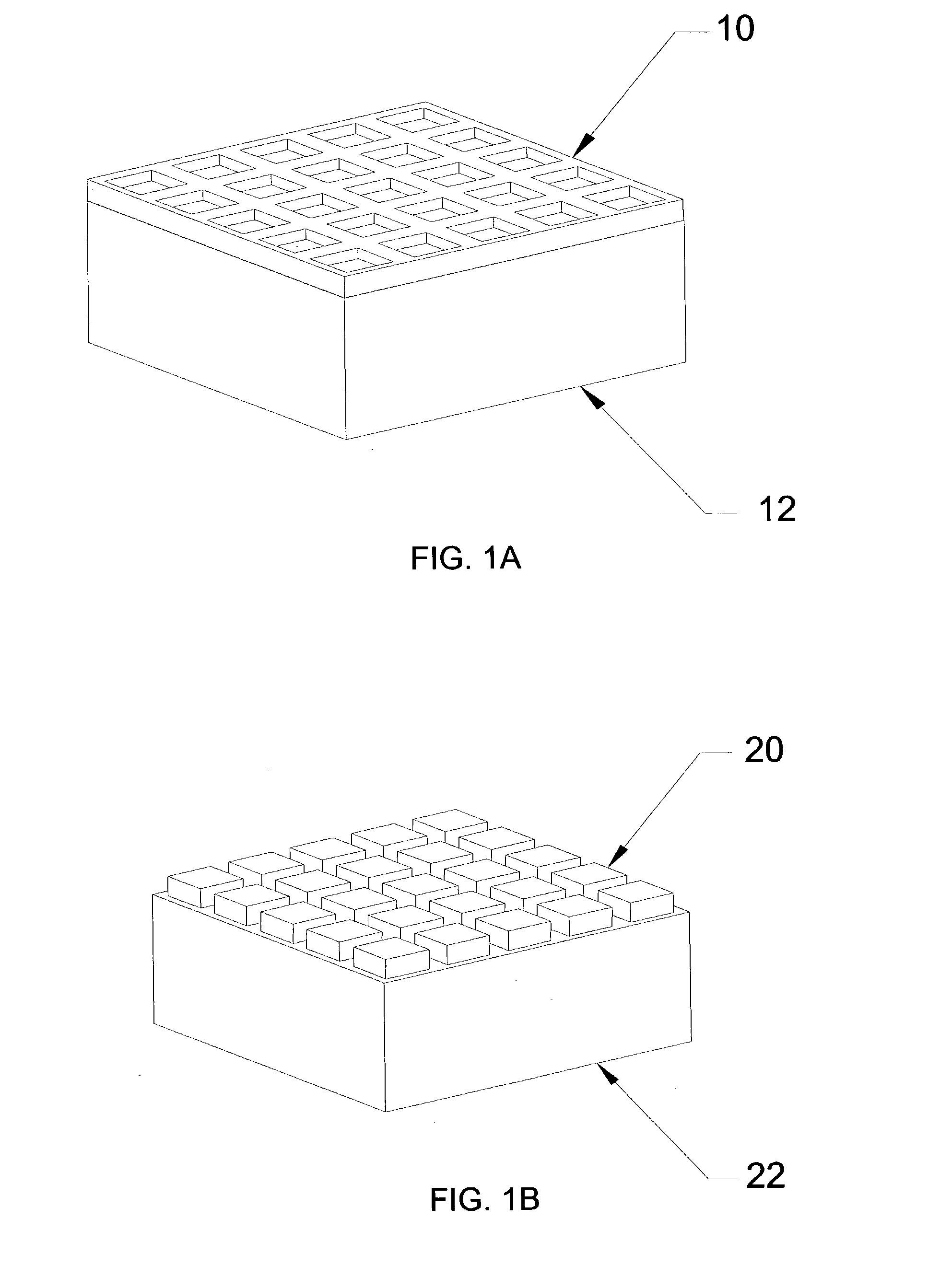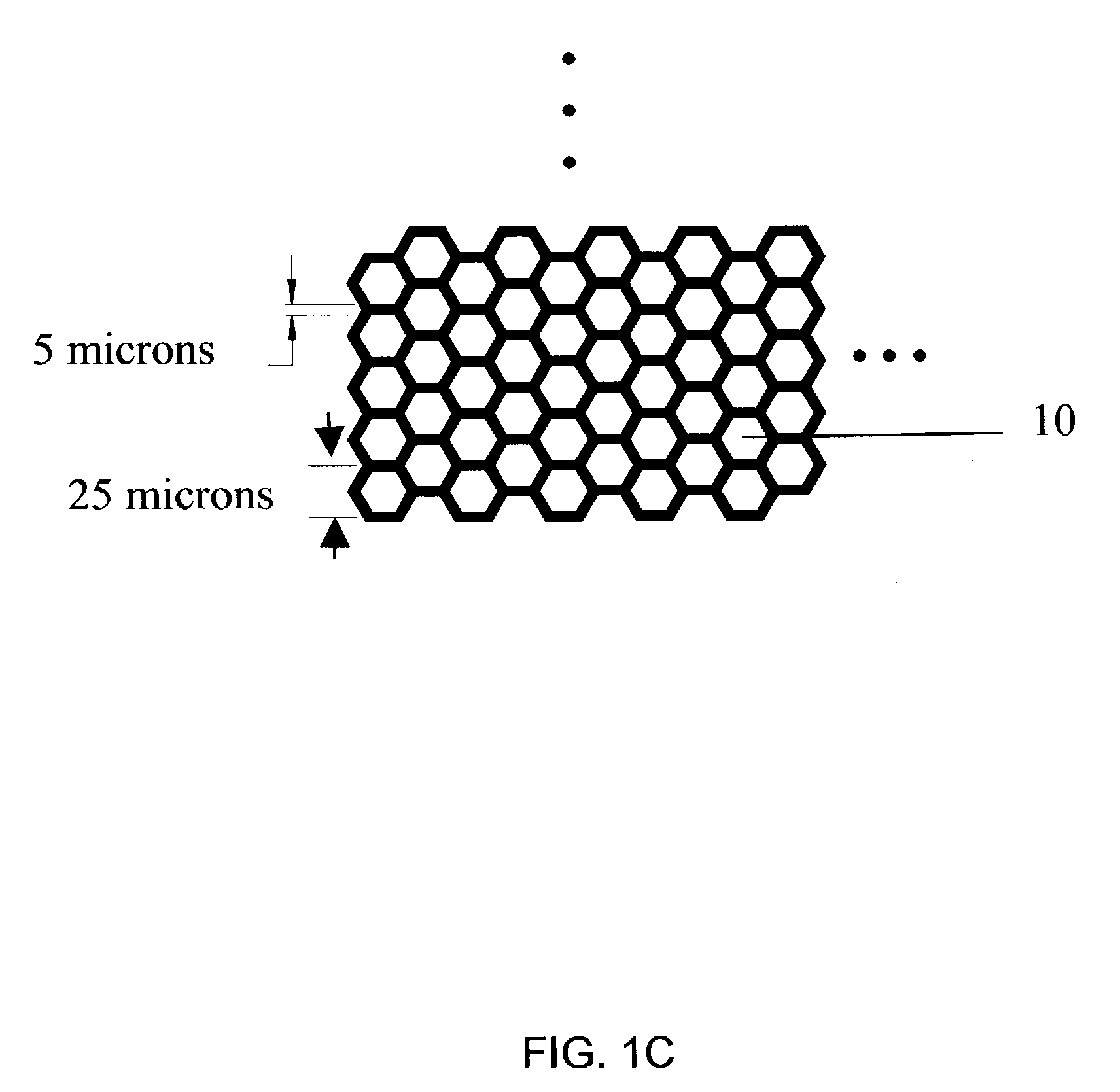High surface area substrates for microarrays and methods to make same
a technology of high surface area and substrate, applied in the field of organic chemistry, biochemistry, molecular biology, etc., can solve the problems of limited access to biomolecules in optimal systems, difficult to achieve with conventional devices, and substantial restrictions on dispensing equipment, so as to improve the uniformity of signal intensity, improve analytical accuracy, and improve the effect of accuracy
- Summary
- Abstract
- Description
- Claims
- Application Information
AI Technical Summary
Benefits of technology
Problems solved by technology
Method used
Image
Examples
example 1
Substrate Having an Accessible Microfeature
[0209]A sodalime silicate glass substrate B270 from Schott Glass (Yonkers, N.Y.) was cleaned and coated by evaporation with a 200 nanometer layer of chromium. The chromium layer was patterned using photolithographic methods to form a series of 7 mm diameter areas comprising nested structural elements, as illustrated in FIGS. 11A to 11C. Each area was patterned differently with respect to the size, shape, and / or density of microfeatures and / or microstructures that were generated in the area.
[0210]The chromium covered patterned substrate was acid etched by immersing in a 6 weight % hydrofluoric acid solution for 30 seconds and rinsed immediately with deionized water. The etch rate was 0.017 microns / second. The chromium was removed from the surface by placing the substrate in a hydrochloric acid (37 weight %) solution at 60° C. with the addition of a small chunk (˜0.2 g) of aluminum as a catalyst. Analysis of the cleaned etched glass substrate...
example 2
Higher Surface Area Afforded by Substrate Comprising Microfeatures
[0212]The silanization process was performed on a textured surface of the substrates made in Example 1. After cleaning, the slides were immediately immersed in deionized H2O to prevent NaOH crystallization. The slides were then rinsed in ethanol and placed in a 50° C. oven to dry. A 1% (v / v) solution of 3-glycidoxypropyltrimethoxysilane in toluene was prepared in a glass vessel into which the slides were immersed for 16 hours. After silanization, the slides were rinsed with toluene and allowed to dry in a 50° C. oven. They were stored under vacuum in a desiccator until use.
[0213]The probe was applied in a 1 / 100 ratio of 5′-Cy3-3′ amine oligonucleotide / ′5 unlabeled-3′ amine olignucleotide onto each feature in 1 μl spots at two final probe concentrations, 25 and 50 μM. Control spots were also placed onto the non-etched area of the slides (i.e., outside of the etched well) and on the non-etched control slides. The slides...
example 3
Generating a Microfeature using a Photoresist
[0215]The substrates of the present invention comprise microfeatures, and the microfeatures were formed using a photoresist coating. The photoresist layer was deposited on the surface of the substrate and was patterned. The resulting walls of the residual photoresist (in the unexposed areas) increased the surface area of the substrate. A flexible photoresist having a wall height in the range of about 2 to about 100 microns is preferably used to generate a microfeature. For example, the Shin-etsu MicroSi (Phoenix, Ariz.) photoresist SINR-3170M series (e.g. SINR-3170M-13) is processed by first uniformly coating a substrate by spin coating. The substrate is cleaned prior to the coating step. The coating parameters are adjusted to control the thickness, and the coated substrate is heated to about 100° C. for 2 minutes. The coated substrate is exposed, using a contact method or a non-contact method, through a patterned mask to an appropriate r...
PUM
| Property | Measurement | Unit |
|---|---|---|
| diameter | aaaaa | aaaaa |
| volume | aaaaa | aaaaa |
| volume | aaaaa | aaaaa |
Abstract
Description
Claims
Application Information
 Login to View More
Login to View More - R&D
- Intellectual Property
- Life Sciences
- Materials
- Tech Scout
- Unparalleled Data Quality
- Higher Quality Content
- 60% Fewer Hallucinations
Browse by: Latest US Patents, China's latest patents, Technical Efficacy Thesaurus, Application Domain, Technology Topic, Popular Technical Reports.
© 2025 PatSnap. All rights reserved.Legal|Privacy policy|Modern Slavery Act Transparency Statement|Sitemap|About US| Contact US: help@patsnap.com



